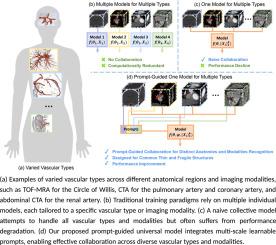收集血管标本在一个柜子:一个层次快速引导的三维血管分割通用模型。
IF 4.9
2区 医学
Q1 ENGINEERING, BIOMEDICAL
Computerized Medical Imaging and Graphics
Pub Date : 2025-10-01
DOI:10.1016/j.compmedimag.2025.102650
引用次数: 0
摘要
体积医学图像中血管结构的准确分割对疾病诊断和手术计划至关重要。虽然深度神经网络已经显示出显著的有效性,但现有的方法往往依赖于针对特定模式和解剖区域定制的单独模型,导致参数冗余和泛化受限。最近的通用模型解决了更广泛的分割任务,但与血管结构的独特挑战作斗争。为了克服这些限制,我们首先提出了VasBench,这是一个新的综合血管分割基准,包括跨越不同模式和解剖区域的9个子数据集。在此基础上,我们介绍了VasCab,一种新颖的快速引导的通用模型,用于体积血管分割,旨在“在一个柜子里收集血管标本”。具体来说,VasCab配备了可学习的域和拓扑提示,以捕获跨不同数据域的共享和独特的血管特征,并辅以形态感知损失来解决复杂的形态变化。实验结果表明,VasCab在所有测试数据集上都超越了个体模型和最先进的医学基础模型,展示了卓越的跨域集成和血管形态变化的精确建模。此外,VasCab在下游任务中表现出强大的性能,强调了其通用性和统一血管分析的潜力。这项研究标志着向通用血管分割迈出了重要的一步,为跨异构数据集的统一血管分析提供了一个有希望的解决方案。代码和数据集可从https://github.com/mileswyn/VasCab获得。本文章由计算机程序翻译,如有差异,请以英文原文为准。

Collect vascular specimens in one cabinet: A hierarchical prompt-guided universal model for 3D vascular segmentation
Accurate segmentation of vascular structures in volumetric medical images is critical for disease diagnosis and surgical planning. While deep neural networks have shown remarkable effectiveness, existing methods often rely on separate models tailored to specific modalities and anatomical regions, resulting in redundant parameters and limited generalization. Recent universal models address broader segmentation tasks but struggle with the unique challenges of vascular structures. To overcome these limitations, we first present VasBench, a new comprehensive vascular segmentation benchmark comprising nine sub-datasets spanning diverse modalities and anatomical regions. Building on this foundation, we introduce VasCab, a novel prompt-guided universal model for volumetric vascular segmentation, designed to “collect vascular specimens in one cabinet”. Specifically, VasCab is equipped with learnable domain and topology prompts to capture shared and unique vascular characteristics across diverse data domains, complemented by morphology perceptual loss to address complex morphological variations. Experimental results demonstrate that VasCab surpasses individual models and state-of-the-art medical foundation models across all test datasets, showcasing exceptional cross-domain integration and precise modeling of vascular morphological variations. Moreover, VasCab exhibits robust performance in downstream tasks, underscoring its versatility and potential for unified vascular analysis. This study marks a significant step toward universal vascular segmentation, offering a promising solution for unified vascular analysis across heterogeneous datasets. Code and dataset are available at https://github.com/mileswyn/VasCab.
求助全文
通过发布文献求助,成功后即可免费获取论文全文。
去求助
来源期刊
CiteScore
10.70
自引率
3.50%
发文量
71
审稿时长
26 days
期刊介绍:
The purpose of the journal Computerized Medical Imaging and Graphics is to act as a source for the exchange of research results concerning algorithmic advances, development, and application of digital imaging in disease detection, diagnosis, intervention, prevention, precision medicine, and population health. Included in the journal will be articles on novel computerized imaging or visualization techniques, including artificial intelligence and machine learning, augmented reality for surgical planning and guidance, big biomedical data visualization, computer-aided diagnosis, computerized-robotic surgery, image-guided therapy, imaging scanning and reconstruction, mobile and tele-imaging, radiomics, and imaging integration and modeling with other information relevant to digital health. The types of biomedical imaging include: magnetic resonance, computed tomography, ultrasound, nuclear medicine, X-ray, microwave, optical and multi-photon microscopy, video and sensory imaging, and the convergence of biomedical images with other non-imaging datasets.

 求助内容:
求助内容: 应助结果提醒方式:
应助结果提醒方式:


